Apples are one of the most popular fruits in the world and for good reason.
They are delicious, versatile, and packed with nutrients.
With so many varieties of apples to choose from, it can be hard to know which one to pick.
In this article, we’ll explore some of the most popular varieties of apples, along with quick facts such as their common names, scientific names, origins, tastes, typical weights, and nutritional values.
How do we get the comparison values for all the types of apples?
The nutritional values presented in this article are sourced from various databases, including the USDA FoodData Central Database when available. Other sources of nutritional information include Nutritionix, My Food Diary, and Cronometer.
1. Ambrosia Apple

Ambrosia is one of the different types of apples that is relatively new compared to some other varieties, having been discovered in British Columbia, Canada in the 1990s.
It was the result of a chance seedling, a cross between a Jonagold and a Golden Delicious apple.
Ambrosia apples have become increasingly popular in recent years, thanks to their sweet flavor and attractive appearance.
The skin of an Ambrosia apple is smooth and glossy, with a creamy yellow background that is striped with bright red.
The flesh is crisp, juicy, and aromatic, with a sweet, honey-like flavor that is low in acid. The texture is similar to a Honeycrisp apple, which is also known for its crispness.
Ambrosia apples are typically available in the fall and winter months, and they are often eaten fresh or used in desserts such as pies and crumbles.
They are also a great addition to salads, where their sweet flavor adds a unique twist to the dish.
In terms of nutrition, Ambrosia apples are a good source of dietary fiber, vitamin C, and antioxidants.
They are also low in calories, with a medium-sized apple containing around 95 calories. Overall, Ambrosia apples are a delicious and nutritious choice for anyone looking to add more fruit to their diet.
Ambrosia Apple Facts
- Common name: Ambrosia
- Scientific name: Malus domestica Ambrosia
- Origin: British Colombia, Canada
- Taste: Sweet and Juicy
- Typical weight: 182g
Ambrosia Apple Nutrition Facts
The nutritional information for an ambrosia apple of medium size, which weighs 182 grams, is provided below (1):
- Apple Calories: 95 kcal
- Carbohydrates: 25 grams
- Fiber: 4.4 grams
- Sugars: 19 grams
- Fat: 0.3 gram
- Protein: 0.5 gram
2. Braeburn Apple

Braeburn is also one of the types of apple that originated in New Zealand in the 1950s.
It is a cultivar of the Lady Hamilton apple and was first discovered as a chance seedling in the orchard of O. Moran in the Moutere Hills of Nelson, New Zealand (2).
Braeburn apples are now widely grown in many parts of the world, including the United States, Australia, Chile, France, and Italy.
Braeburn apples are known for their sweet-tart flavor, crispy texture, and attractive appearance.
They are typically medium to large in size and have a bright red and green skin coloration that can vary depending on the climate and growing conditions.
Braeburn apples are harvested in the fall and can be stored for several months, making them a popular apple variety for both fresh consumption and cooking.
Braeburn apples are a good source of fiber and vitamin C, and they are also low in calories.
They can be eaten on their own as a snack or used in a variety of dishes, including pies, tarts, sauces, and salads.
Overall, Braeburn apples are a versatile and flavorful apple variety that is enjoyed by many around the world.
Braeburn Apple Facts
- Common name: Braeburn
- Scientific name: Malus domestica Braeburn
- Origin: Nelson, New Zealand (the 1950s)
- Taste: Sweet, juicy, slightly tart
- Typical weight: 133 grams
Braeburn Apple Nutrition Facts
Here is the nutritional information for a medium-sized (133-gram) Braeburn apple (3):
- Apple Calories: 72 kcal
- Carbohydrates: 16 grams
- Fiber: 2.4 grams
- Sugars: 16 grams
- Fat: 0.1 gram
- Protein: 0.5 gram
3. Bramley Apple
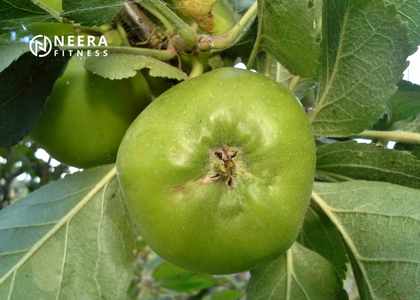
Bramley apple is also one of the types of apple majorly used for cooking and is known for its tart, acidic flavor, and firm texture.
It is a popular variety of apples in the United Kingdom, and it is often used in traditional British recipes such as apple pie, apple crumble, and apple sauce.
The Bramley apple was first grown by a man named Matthew Bramley in the town of Southwell in Nottinghamshire, England in the 19th century.
Bramley sold the rights to his apple tree to a local nurseryman named Henry Merryweather, who began to propagate and sell the apples under the name “Bramley’s Seedling”.
Bramley apples are usually quite large and green in color, with a slightly ribbed surface.
They are typically harvested in October and November and are available in many UK supermarkets and greengrocers throughout the autumn and winter months.
Bramley apples are versatile in the kitchen and can be used in a wide variety of sweet and savory dishes.
They are particularly well-suited to cooking because their firm texture holds up well when baked or stewed.
Bramley Apple Facts
- Common name: Bramley
- Scientific name: Malus domestica Bramley’s Seedling
- Origin: Nottinghamshire, England
- Taste: Slight sweet notes but very tart, very sour
- Typical weight: 200 grams
Bramley Apple Nutrition Facts
Here are the nutritional values for a medium-sized Bramley Apple (200g) (4):
- Apple Calories: 82 kcal
- Carbohydrates: 21 grams
- Fiber: 3.2 grams
- Sugars: 17.8 grams
- Fat: 0.2 gram
- Protein: 0.6 gram
4. Cortland Apple
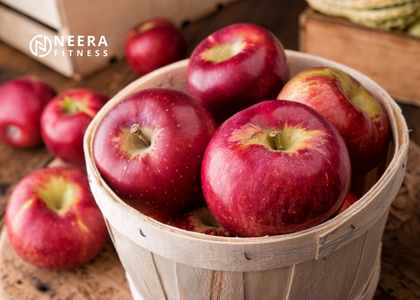
The Cortland apple is also one of the types of apples that is popular for its sweet flavor and crisp texture.
It is a cross between the Ben Davis and McIntosh apple varieties and was first developed in 1898 at the New York State Agricultural Experiment Station in Geneva, New York (5).
Cortland apples are typically medium to large in size and have bright red skin with some yellow or green coloring.
The flesh of the Cortland apple is white, juicy, and slightly tart, with a fine-grained texture that is ideal for eating raw or using in cooking.
Cortland apples are great for baking, as they hold their shape well and do not become too soft or mushy when cooked.
They are also a popular choice for making apple sauce, as their natural sweetness and slightly tart flavor make for a tasty and balanced sauce.
Cortland apples are generally available from September through December in the United States and can be found at many farmers’ markets, grocery stores, and orchards.
They are a popular choice for eating out of hand, but can also be used in a variety of recipes, including pies, tarts, and salads.
Cortland Apple Facts
- Common name: Cortland
- Scientific name: Malus domestica Cortland
- Origin: New York, United States
- Taste: Slightly sweet yet partly tart
- Typical weight: 154 grams
Cortland Apple Nutrition Facts
A regular Cortland apple has the following nutritional properties (6):
- Apple Calories: 80 kcal
- Carbohydrates: 20.9 grams
- Fiber: 4.0 grams
- Sugars: 16.0 grams
- Fat: 0 gram
- Protein: 0 gram
5. Empire Apple
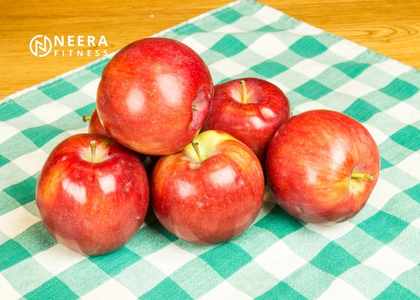
The Empire apple is a popular variety of apples that was developed in the United States in the 1940s.
It is a cross between the Red Delicious and McIntosh apple varieties, and it is named after the Empire State, which is the nickname for the state of New York (7).
The Empire apple has a sweet-tart flavor and a crisp, juicy texture. It is a medium-sized apple with bright red skin that sometimes has green or yellow highlights.
The flesh is white and firm, and it is good for eating fresh, baking, or making juice or cider.
The Empire apple is grown in many regions of the world, including the United States, Canada, and Europe.
It is a popular choice for commercial growers and home gardeners alike because it is disease-resistant and has a long shelf life.
Empire Apple Facts
- Common name: Empire
- Scientific name: Malus domestica Empire
- Origin: New York, United States
- Taste: Sweet, firm
- Typical weight: 154 grams
Empire Apple Nutrition Facts
The nutritional values of a regular empire Apple are as below (8):
- Apple Calories: 80 kcal
- Carbohydrates: 22 grams
- Fiber: 4.9 grams
- Sugars: 16.0 grams
- Fat: 0 gram
- Protein: 0 gram
6. Fuji Apple

The Fuji apple is a popular variety of apples that was first developed in Japan in the late 1930s and introduced to the United States in the 1980s.
It is named after the town of Fujisaki in Japan, where it was first grown (9).
The Fuji apple is a medium to large-sized apple with a round, squat shape. It has a yellow-green background with a red-pink blush on the skin.
The flesh is crisp and juicy, and it has a sweet, slightly tart flavor with hints of honey.
The Fuji apple is popular for its versatility in cooking and eating. It is a good choice for fresh eating, as well as for baking, cooking, and making juice or cider.
It also has a long shelf life, which makes it a popular choice for commercial growers and supermarkets.
In addition to its delicious taste, the Fuji apple is also known for its health benefits.
It is a good source of dietary fiber, vitamin C, and antioxidants, and it may help lower the risk of heart disease, diabetes, and certain types of cancer.
Fuji Apple Facts
- Common name: Fuji
- Scientific name: Malus pumila Fuji
- Origin: Aomari, Japan in late 1930s
- Taste: Sweet, Juicy, and slightly tart flavor
- Typical weight: 192 grams
Fuji Apple Nutrition Facts
Medium-sized Fuji apple has the following nutritional values (192 gram) (10):
- Apple Calories: 121 kcal
- Carbohydrates: 29.2 grams
- Fiber: 4.0 grams
- Sugars: 22.5 grams
- Fat: 0 gram
- Protein: 0.4 gram
7. Gala Apple

The Gala apple is a popular variety of apples that was first developed in New Zealand in the 1930s. It is a cross between two apple varieties, the Kidd’s Orange Red and the Golden Delicious (11).
The Gala apple has a sweet, mild flavor and a crisp texture. It is medium-sized with a round to oblong shape, and it has thin, smooth skin that is typically yellow-orange with red stripes. The flesh is yellow-white, and it is juicy and aromatic.
Gala apples are a popular choice for eating fresh because of their sweet flavor and crisp texture. They are also good for cooking and baking, as they hold their shape well and do not turn mushy when cooked. They are a common ingredient in salads, pies, and other baked goods.
In addition to their delicious taste, Gala apples are also a good source of fiber, vitamin C, and other nutrients. They may help to lower the risk of heart disease, stroke, and other chronic diseases when consumed as part of a healthy diet.
Gala Apple Facts
- Common name: Gala
- Scientific name: Malus domestia Gala
- Origin: New Zealand
- Taste: Sweet and crisp texture
- Typical weight: 178 grams
Gala Apple Nutrition Facts
Here are the nutritional values of one medium-sized Gala apple (12):
- Apple Calories: 98 kcal
- Carbohydrates: 23.6 grams
- Fiber: 4.0 grams
- Sugars: 17.9 grams
- Fat: 0 gram
- Protein: 0.4 gram
8. Golden Delicious Apple
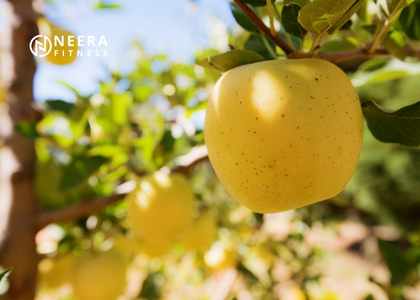
The Golden Delicious apple is also one of the types of apple that were first discovered in West Virginia, United States, in the late 19th century (13).
It is a cross between the Grimes Golden and the Golden Reinette apple varieties.
The Golden Delicious apple has a sweet, mellow flavor with juicy and tender flesh. It is medium to large in size and has smooth, golden yellow-green skin that sometimes has a slight blush of pink or red.
Golden Delicious apples are a popular choice for eating fresh, as well as for cooking and baking. They hold their shape well when cooked and have a mild flavor that complements many other ingredients.
Golden Delicious Apple Facts
- Common name: Golden Delicious
- Scientific name: Malus domestica Golden Delicious
- Origin: West Virginia, United States
- Taste: Sweet, Juicy
- Average weight: 169 grams
Golden Delicious Apple Nutrition Facts
Here are the nutritional values of a medium Golden Delicious apple (14):
- Apple Calories: 96 kcal
- Carbohydrates: 23.0g
- Fiber: 4.1g
- Sugars: 16.9g
- Fat: 0.3g
- Protein: 0.5g
9. Granny Smith Apple
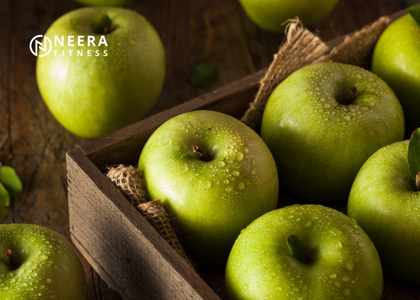
The Granny Smith apple is also one of the types of apple that were first discovered in Australia in the mid-1800s by Maria Ann Smith, also known as “Granny” Smith (15). It is a cross between two apple varieties, the French Crabapple, and the Rome apple.
The Granny Smith apple is known for its tart flavor and firm, crisp texture. It has bright green skin that is often speckled with white spots, and the flesh is juicy and white. It is a medium to large-sized apple with a round shape.
Granny Smith apples are a popular choice for cooking and baking, as they hold their shape well and their tart flavor pairs well with sweet ingredients. They are often used in pies, tarts, and other desserts, as well as in savory dishes like salads and stews. They are also enjoyed as a snack, particularly by those who prefer a tart flavor in their apples.
At present, the Granny smith apple is one of the most popular and produced apples in the world. In fact, according to a survey forecast for 2021, it is the fifth-highest-producing apple out of all the apples in the United States (16).
Granny Smith Apple Facts
- Common name: Granny Smith
- Scientific name: Malus domestica Granny Smith
- Origin: New South Wales, Australia
- Taste: Sweet, slightly tart, juicy
- Average weight: 167grams
Granny Smith Apple Nutrition Facts
A medium-sized (167-gram) Granny Smith apple contains the following nutritional values (17):
- Apple Calories: 97 kcal
- Carbohydrates: 22.7 grams
- Fiber: 4.7 grams
- Sugars: 16.0 grams
- Fat: 0.3 gram
- Protein: 0.7 gram
10. Honeycrisp Apple
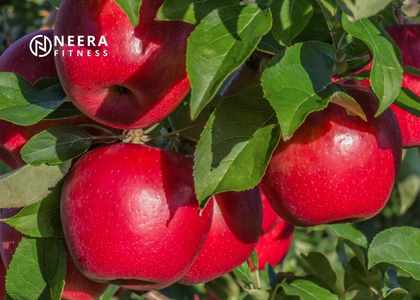
Honeycrisp is a variety of apples that was developed at the University of Minnesota in the 1960s and introduced commercially in the 1990s (18).
It is known for its sweet, juicy, and crunchy texture, making it one of the most popular apple varieties in the United States and Canada.
Honeycrisp apples have a distinct red and green coloration and are typically medium to large in size.
They are also known for their long shelf life and resistance to bruising, which makes them a popular choice for commercial growers and consumers alike.
However, they are generally more expensive than other apple varieties due to their popularity and the cost of producing them.
Honeycrisp Apple Facts
- Common name: Honeycrisp
- Scientific name: Malus pumila Honeycrisp
- Origin: Minnesota, United States
- Taste: Sweet, Juicy
- Average weight: 182 grams
Honeycrisp Apple Nutrition Facts
Here is the nutritional value of an average medium (182-gram) Honeycrisp apple (19):
- Apple Calories: 95 kcal
- Carbohydrates: 25.0 grams
- Fiber: 4.4 grams
- Sugars: 19.0 grams
- Fat: 0.3 gram
- Protein: 0.5 gram
11. Jazz Apple
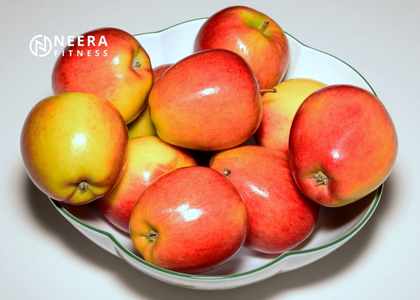
Jazz is a relatively new variety of apples that was developed in New Zealand in the 1980s and first introduced to the market in 2004.
It is a cross between the Gala and Braeburn apple varieties and is known for its unique combination of sweetness and tartness (20).
Jazz apples have a crisp and juicy texture, with a deep red and yellow skin coloration that is similar to that of the Gala apple.
They are typically medium to large in size and have become increasingly popular in recent years due to their distinctive flavor profile and high nutritional content.
Jazz apples are also known for their long shelf life and ability to stay fresh even when stored at room temperature, making them a convenient and popular choice for consumers.
Jazz Apple Facts
- Common name: Jazz
- Scientific name: Malus domestica Scifresh
- Origin: New Zealand
- Taste: Sweet, juicy, slightly tart notes
- Average weight: 182 grams
Jazz Apple Nutrition Facts
A medium-sized (154 grams) Jazz apple contains the following nutrition values (21):
- Apple Calories: 80 kcal
- Carbohydrates: 22.0 grams
- Fiber: 5.0 grams
- Sugars: 16.0 grams
- Fat: 0 gram
- Protein: 0 gram
12. Jonagold Apple
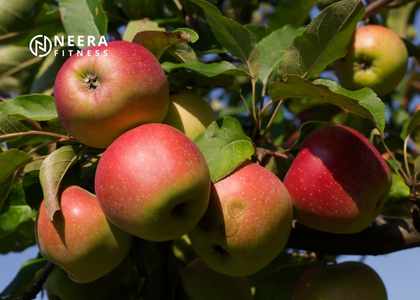
Jonagold is also one of the different types of apple that were developed in the 1950s in the United States by combining the Jonathan and Golden Delicious apple varieties (22).
It is a large, sweet apple that has a firm and juicy texture with a slightly tart flavor.
The skin of a Jonagold apple is yellow-green with red striping, and the flesh is creamy yellow in color.
Jonagold apples are commonly used for eating fresh, as well as for baking, cooking, and making apple juice and cider.
Jonagold apples are considered to be a good source of fiber, vitamins, and antioxidants, and are a popular choice among health-conscious consumers.
Jonagold Apple Facts
- Common name: Jonagold
- Scientific name: Malus domestica Jonagold
- Origin: New York, USA
- Taste: Mild, sweet
- Average weight: 154 grams
Jonagold Apple Nutrition Facts
A medium (154 grams) Jonagold apple contains the following nutritional values (23):
- Apple Calories: 80 kcal
- Carbohydrates: 22 grams
- Fiber: 4.9 grams
- Sugars: 16.0 grams
- Fat: 0 gram
- Protein: 0.5 gram
13. McIntosh Apple
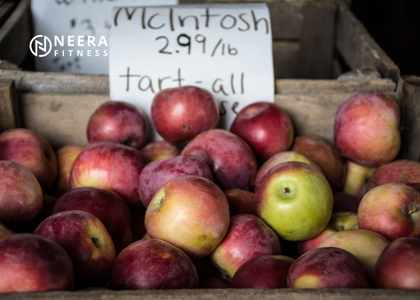
McIntosh is a variety of apples that originated in Canada in the early 19th century and is named after its discoverer, John McIntosh.
It is a medium-sized apple with a round shape and has a red and green skin coloration that is slightly waxy to the touch. The flesh of a McIntosh apple is white, with a crisp and juicy texture and a slightly tart flavor that becomes sweeter as the apple ripens.
One unique characteristic of the McIntosh apple is that it is particularly aromatic, with a distinctive perfume-like fragrance that is especially noticeable when the apple is cut or bitten into.
The McIntosh apple is also well-suited for making applesauce, due to its tender texture and natural sweetness, and is a popular choice for apple pies and other baked goods.
McIntosh Apple Facts
- Common name: McIntosh
- Scientific name: Malus domestica McIntosh
- Origin: Ontario, Canada
- Taste: Sweet, tart, tangy
- Average weight: 150 grams
McIntosh Apple Nutrition Facts
A medium (150-gram) McIntosh apple has the following nutritional values:
- Apple Calories: 80 kcal
- Carbohydrates: 21 grams
- Fiber: 4 grams
- Sugars: 16 grams
- Fat: 0 gram
- Protein: 0.4 gram
14. Pink Lady Apple
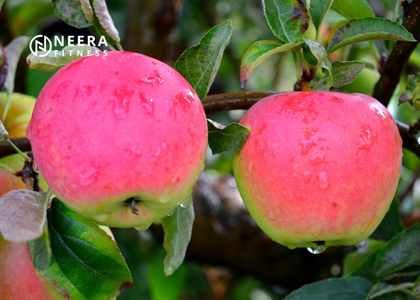
Pink Lady is a type of apple that originated in Western Australia in the 1970s and is a cross between the Golden Delicious and Lady Williams apple varieties (24).
It is a medium to large-sized apple with a distinctive pink and green skin coloration and has a firm and crisp texture with a sweet-tart flavor.
Pink Lady apples are known for their high sugar content, which gives them a particularly sweet taste, and their ability to resist browning when cut, which makes them a popular choice for salads and other dishes.
They are generally available in the fall and winter months and are grown in many regions around the world, including the United States, Europe, and Australia.
Pink Lady Apple Facts
- Common name: Pink Lady
- Scientific name: Malus domestica Cripps Pink
- Origin: Western Australia
- Taste: Sweet, tart, and juicy
- Average weight: 133 grams
Pink Lady Apple Nutrition Facts
A regular 133-gram Pink Lady apple has the following nutritional values:
- Apple Calories: 71 kcal
- Carbohydrates: 18.1g
- Fiber: 2.40g
- Sugars: 15.7g
- Fat: 0.10g
- Protein: 0.5g
15. Red Delicious Apple
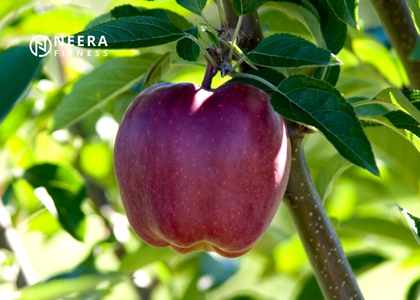
The Red Delicious apple is a popular variety of apples that is known for its bright red skin, elongated shape, and mildly sweet flavor.
It was first discovered in Iowa in the 1880s and was introduced to the market in 1892 (25, 26).
The Red Delicious apple quickly became a favorite among consumers and is now one of the most widely produced apple varieties in the world.
The Red Delicious apple is commonly used for snacking, but it can also be used in cooking and baking.
Its firm flesh holds up well when cooked, making it a popular choice for pies, tarts, and other desserts. While it is a versatile apple, it is important to note that the Red Delicious apple has a relatively short shelf life and may not be the best choice for long-term storage.
Red Delicious Apple Facts
- Common name: Red Delicious
- Scientific name: Malus domestica Red Delicious
- Origin: Iowa, United States
- Taste: Mild, sweet
- Average weight: 212 grams
Red Delicious Apple Nutrition Facts
A medium (212 grams) Red Delicious apple has the following nutritional values (27):
- Apple Calories: 125 kcal
- Carbohydrates: 29.9 grams
- Fiber: 4.9 grams
- Sugars: 22.3 grams
- Fat: 0.4 gram
- Protein: 0.6 gram
Frequently Asked Questions and Answers
Here are some basic questions and their answers that people may ask about the different types of apples.
What is the rarest type of apple?
The rarest type of apple is difficult to determine and may vary by location. Rare and heirloom varieties like the Pitmaston Pineapple and Black Oxford are prized for their unique flavors and histories, along with lesser-known local cultivars.
Which variety of apples is the sweetest?
It’s difficult to say which variety of apples is the sweetest since sweetness can vary based on factors like ripeness and growing conditions. However, some commonly known sweet varieties include Honeycrisp, Gala, Fuji, and Red Delicious. Taste preference can also be subjective.
Which apple is best for eating?
Many apples are good for eating, but some of the most popular and widely available varieties include Honeycrisp, Gala, Fuji, and Pink Lady. These apples have a good balance of sweetness and crispness and are often enjoyed fresh as a snack. Taste preference can vary, so it’s best to try a few different types to find your personal favorite.
What apples have a tart taste?
Some apples have a tart taste, which can be attributed to their higher acid content. Examples of tart apple varieties include Granny Smith, Braeburn, Jonathan, and Winesap. These apples are often used in cooking and baking because their tartness can provide a balance to sweet ingredients.
Why is an apple a healthy choice?
Apples are a healthy choice because they are low in calories, high in fiber, and a good source of vitamins and antioxidants. Eating apples can help regulate blood sugar, lower cholesterol, and improve digestion. They can also promote feelings of fullness, making them a good snack choice for weight management.
Conclusion
There are many different types of apples, each with its own unique flavor, texture, and uses. Some popular varieties include Honeycrisp, Gala, Fuji, and Red Delicious, while others like Granny Smith and Braeburn have a tart taste.
Some rare and heirloom varieties also exist, and all apples offer health benefits such as being low in calories, high in fiber, and a good source of vitamins and antioxidants. Overall, there is an apple for every taste preference and recipe.














